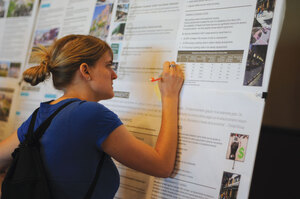Community discusses future growth
Students and local residents gathered to learn and comment on upcoming development projects in the neighborhood at a Los Angeles Department of City Planning community workshop held Saturday.
From 9 a.m. to noon, nearly 200 community members trickled through the open doors of the Galen Center’s Founders Club to weigh in on a number of proposed changes to the South and Southeast Los Angeles regions by writing comments on the enlarged maps and diagrams on display. An invitation to the event advertised both the issues of commercial revitalization and neighborhood conservation, as well as the opportunity to assist in planning the areas surrounding the Exposition Line stations currently under construction.

Cartographer · Sarah Stoker, a community member, writes her comments on a map of the area at a city planning community workshop. - Eric Burse | Daily Trojan
The event marked the first time the Founders Club had been used to house a community input workshop, which actually fulfilled an
ongoing university obligation to accommodate events serving the residents of the surrounding
neighborhood through the university’s Civic and Community Relations department.
“The Galen Center needed city approval to be constructed,” said David Galaviz, executive director of USC Local Government Relations. “And a part of the condition of the Galen Center’s construction was that it be made available for community uses.”
Most of the changes proposed at the meeting, especially those
falling under the designation of “Design Standards and Use Limitations,” were conceived in response to either resident demands or perceived local needs.
“We’re focused on the community holistically,” said Jenny Scanlin, downtown region project manager of the Community Redevelopment Agency. She described the agency’s ongoing redevelopment efforts to inquiring workshop participants. “We’re focused on bringing in new housing … Combined, we have about 265 units of affordable housing coming in.”
Other proposed changes include granting certain areas, such as Jefferson Park and Vermont Square, designations as Historic Preservation Overlay Zones. According to City of Los Angeles City Planning Associate Griselda Gonzalez, HPOZ status is typically granted to maintain a given neighborhood’s existing character and to promote consistency in architecture and design.
Considering the city’s
already-stretched finances, 2009 might not seem the ideal year to propose changes of this scope and scale. But Pete Wilson, a local architect who participated in the event, said the present climate of uncertainty is precisely suited to cultivate innovation.
“Los Angeles has to change, so being ambitious is a good idea right now,” Wilson said.
As per the Department of City Planning’s previously outlined steps toward a community plan update, input gleaned from Saturday’s workshop is to be incorporated into the first draft of the updated plan, which will again be presented to the public at an open house forum. A subsequent public hearing will allow for the submission of formal testimony — written or verbal — in response to the draft plan. Only after receiving approval from the Area Planning Commission, the City Planning Commission and the Planning and Land Use subcommittee will the modified community plan be submitted to the City Council for revision and eventual approval.
The location of the workshop — they are usually held at municipal areas such as libraries — allowed for more participation and input from the USC community.
Eric Bruins, a senior majoring in public policy, management and planning, took advantage of this location. Bruins, who currently works with A Place Called Home, a community center in South Los Angeles, said he was focusing his attention on bicycle issues in the city.
“We’re trying to make that potential bike lane into an actual bike lane,” Bruins said, indicating a dotted line on the map of Downtown before him. “It seems silly to devote two-thirds of the roadway to private transportation when that’s not the primary way people get around.”
Bruins said he was pleasantly surprised by his experience with the city planners staffing the workshop.
“It was really positive,” Bruins said. “They were really accessible and willing to talk with us and answer questions.”
Despite the relatively convenient location, the number of USC students at the workshop seemed minimal.
Jennifer Yee, a junior majoring in comparative literature who belongs to the student organization Campus and Community United, said the small turnout was because of the way students relate to the area.
“There’s a lot of segregation between the students and the neighborhood,” Yee said. “People are leaving after four years.”
Gonzalez’s explanation of the less-than-overwhelming USC presence echoed Yee’s.
“I think maybe USC students may not be too familiar with the issues of South Los Angeles,” Gonzalez said. “Students are just here for a
limited amount of time. I think some of them may not feel that they’re
affected by the long term issues that face South LA.”
